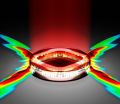Right place, right time: Cellular transportation compartments
2014-10-26
(Press-News.org) Stanford, CA— Proteins are the machinery that accomplishes almost every task in every cell in every living organism. The instructions for how to build each protein are written into a cell's DNA. But once the proteins are constructed, they must be shipped off to the proper place to perform their jobs. New work from a team of scientists led by Carnegie's Munevver Aksoy and Arthur Grossman, describes a potentially new pathway for targeting newly manufactured proteins to the correct location. Their work is published by The Plant Cell.
The team's discovery concerns a cellular organelle that has been called an acidocalcisome. It is a compartment that isolates potential harmful or disruptive compounds from the rest of the cell and is also involved in the turnover of cellular components (similar to the so-called lysosome in animals). They are rich in phosphate-containing molecules and the team noted that they build up to high levels when cells of the single-celled, green alga Chlamydomonas are deprived of sulfur. They discovered that acidocalcisomes are also, surprisingly, involved in targeting proteins out into the cell space between the cell's membrane and the cell wall.
Working with Chlamydomonas, the team, which also included Carnegie's Wirulda Pootakham, was examining the organism's responses to nutrient deficiency. They found that mutant cells lacking the ability to form these acidocalcisomes also lacked the ability to cope with sulfur and nitrogen deprivation adequately.
What appears to happen with these mutants is that the proteins that specialize in helping the cell survive a deficiency of sulfur or nitrogen don't get shipped out to the space between the membrane and cell wall where they are needed. Because of this, feedback is sent to stop construction of the proteins (and the messenger RNA that encodes those proteins) and the entire response to nutrient deficiency is derailed.
"Our findings point to a novel way to target proteins to where they're needed to function, and indicate that this targeting is also associated with checkpoints that might control gene transcription," Grossman said.
These findings tie in with new work from Sabeeha Merchant at UCLA, with whom Grossman's lab will be working to explore the interrelatedness of their discoveries.
Merchant's team used a combination of various spectroscopic methods to visualize a metal-storing compartment in Chlamydomonas that may be similar or related to that studied by Grossman. The compartment studied by Merchant specializes in storing copper and in making it available when it is necessary for the construction of certain proteins. Their work is published in Nature Chemical Biology.
"We wonder whether there are actually different types of acidocalcisomes or vacuoles in any one cell, each housing different amounts of individual metals," Merchant said. "We look forward to working together to explore the new possibilities in understanding mineral nutrient metabolism brought to light by our two papers, which underscore the interplay between multiple pathways for maintaining normal cellular function."
INFORMATION:
This work is supported by the Department of Energy.
The UCLA work is supported by NIH, DOE, and the German Academic Exchange Service.
The Carnegie Institution for Science is a private, nonprofit organization headquartered in Washington, D.C., with six research departments throughout the U.S. Since its founding in 1902, the Carnegie Institution has been a pioneering force in basic scientific research. Carnegie scientists are leaders in plant biology, developmental biology, astronomy, materials science, global ecology, and Earth and planetary science.
ELSE PRESS RELEASES FROM THIS DATE:
2014-10-26
October 26, 2014, New York, NY – Ludwig Oxford researchers have discovered a key mechanism that governs how cells of the epithelia, the soft lining of inner body cavities, shift between a rigid, highly structured and immobile state and a flexible and motile form. Published in the current issue of Nature Cell Biology, their study shows that a tumor suppressor protein named ASPP2 functions as a molecular switch that controls this process and its reverse, both of which play a critical role in a number of biological phenomena, including wound healing, embryonic development ...
2014-10-26
PROVIDENCE, R.I. [Brown University] — Superconductors and magnetic fields do not usually get along. But a research team led by a Brown University physicist has produced new evidence for an exotic superconducting state, first predicted a half-century ago, that can indeed arise when a superconductor is exposed to a strong magnetic field.
"It took 50 years to show that this phenomenon indeed happens," said Vesna Mitrovic, associate professor of physics at Brown University, who led the work. "We have identified the microscopic nature of this exotic quantum state of ...
2014-10-26
Scientists have created cells with fluorescent dyes that change color in response to specific neurochemicals. By implanting these cells into living mammalian brains, they have shown how neurochemical signaling changes as a food reward drives learning, they report in Nature Methods online October 26.
These cells, called CNiFERs (pronounced "sniffers"), can detect small amounts of a neurotransmitter, either dopamine or norepinephrine, with fine resolution in both location and timing. Dopamine has long been of interest to neuroscientists for its role in learning, reward, ...
2014-10-26
Lasers – devices that deliver beams of highly organized light – are so deeply integrated into modern technology that their basic operations would seem well understood. CD players, medical diagnostics and military surveillance all depend on lasers.
Re-examining longstanding beliefs about the physics of these devices, Princeton engineers have now shown that carefully restricting the delivery of power to certain areas within a laser could boost its output by many orders of magnitude. The finding, published Oct. 26 in the journal Nature Photonics, could allow ...
2014-10-26
NEW YORK, NY (October 26, 2014)—Dietary cocoa flavanols—naturally occurring bioactives found in cocoa—reversed age-related memory decline in healthy older adults, according to a study led by Columbia University Medical Center (CUMC) scientists. The study, published today in the advance online issue of Nature Neuroscience, provides the first direct evidence that one component of age-related memory decline in humans is caused by changes in a specific region of the brain and that this form of memory decline can be improved by a dietary intervention.
As ...
2014-10-26
MOUNT WILSON, Calif.–Astronomers at Georgia State University's Center for High Angular Resolution Astronomy (CHARA) have observed the expanding thermonuclear fireball from a nova that erupted last year in the constellation Delphinus with unprecedented clarity.
The observations produced the first images of a nova during the early fireball stage and revealed how the structure of the ejected material evolves as the gas expands and cools. It appears the expansion is more complicated than simple models previously predicted, scientists said. The results of these observations, ...
2014-10-26
BOSTON –– Scientists say they have identified in about 20 percent of colorectal and endometrial cancers a genetic mutation that had been overlooked in recent large, comprehensive gene searches. With this discovery, the altered gene, called RNF43, now ranks as one of the most common mutations in the two cancer types.
Reporting in the October 26, 2014 edition of Nature Genetics, investigators from Dana-Farber Cancer Institute and the Broad Institute of MIT and Harvard said the mutated gene helps control an important cell-signaling pathway, Wnt, that has been ...
2014-10-26
Why do we remember some things and not others? In a unique imaging study, two Northwestern University researchers have discovered how neurons in the brain might allow some experiences to be remembered while others are forgotten. It turns out, if you want to remember something about your environment, you better involve your dendrites.
Using a high-resolution, one-of-a-kind microscope, Daniel A. Dombeck and Mark E. J. Sheffield peered into the brain of a living animal and saw exactly what was happening in individual neurons called place cells as the animal navigated a virtual ...
2014-10-26
Digoxin, a medication used in the treatment of heart failure, may be adaptable for the treatment of amyotrophic lateral sclerosis (ALS), a progressive, paralyzing disease, suggests new research at Washington University School of Medicine in St. Louis.
ALS, also known as Lou Gehrig's disease, destroys the nerve cells that control muscles. This leads to loss of mobility, difficulty breathing and swallowing and eventually death. Riluzole, the sole medication approved to treat the disease, has only marginal benefits in patients.
But in a new study conducted in cell cultures ...
2014-10-26
CHAMPAIGN, Ill. — Researchers report in the journal Nature that they have made a breakthrough in understanding how a powerful antibiotic agent is made in nature. Their discovery solves a decades-old mystery, and opens up new avenues of research into thousands of similar molecules, many of which are likely to be medically useful.
The team focused on a class of compounds that includes dozens with antibiotic properties. The most famous of these is nisin, a natural product in milk that can be synthesized in the lab and is added to foods as a preservative. Nisin has ...
LAST 30 PRESS RELEASES:
[Press-News.org] Right place, right time: Cellular transportation compartments






